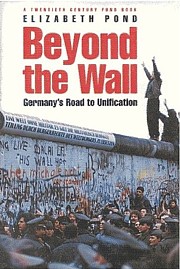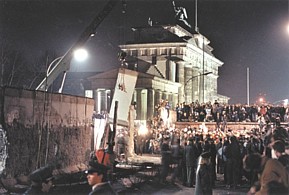Essay (back
to top)
When the Berlin wall went up in 1961 it looked as though the dream of a once again unified Germany was to stay just that, a dream. Almost three decades later this dream was once again rekindled, and this time it did not remain a mere dream or wish for the future, it became a reality as solid as the wall that divided the German nation for so many years. In her book, Beyond the Wall; Germany’s Road to Unification, Elizabeth Pond delivers a detailed play by play of the politics and diplomacy that went into the ultimate reunification of Germany.
Beyond the Wall starts with the undeniably emotional day in November of 1989, when Berliners were able break free of the barrier that had separated them and celebrate as not just Easterners and Westerners, but as Germans. Pond then delves into the past with a brief description of the post WWII events in both the east and west that led up to the construction of the wall. With the grounds of East and West German diplomacy mapped out, the discussion then moves into explaining the European political situation of the 1980s that played a major role in the outcome of events. The book delivers detailed descriptions of the nuclear standoff between the United States and Russia that centered on Germany and the problems facing both Eastern and Western Europe, showing the need for a strong Europe and subsequently a strong German Nation. Pond then explains how these factors, coupled with the Germans’ desire for a better future for themselves and their children, brought about the relatively short, but at times bumpy, road to unification. The book ends with a summation of the effects of the fall of the wall and a look forward into what the future holds for not only Germany, but the United States and Europe as Germany once again becomes an international force.
The 1980s was a tumultuous time in European, and more specifically, German history. The 1989 crumbling of the Berlin wall proved to be both the beginning and the end of Germany’s problems. It is ironic that this catalyst for the unification of Germany, and in many ways Europe, happened seventy one years to the day after the collapse of imperial Germany, giving Germany a second chance at forming a solid nation, but this time one free of Nazi atrocities. The events that followed the fall were to shape the outcome of the seemingly never-ending German question and the landscape of European politics. Pond argues that the reunification of Germany was more than just a result of the two Germanies mending their differences; it was in reality an amalgam of social, political, and economic forces acting as one that ultimately fused the German nations back into a single Germany.
Perhaps some of the most important factors in dictating the path and timing of Germany’s road to unification were the decisions and interactions of international players. The two obvious stars in this theater were the United States and former Soviet Union, with supporting, but equally important roles played by France and Britain. Since the end of WWII the United States had been in the midst of the Cold War with the Soviet Union which included an ongoing nuclear standoff between the two nations (heightening at the Bay of Pigs in 1963). In the 1980s the Germans came to depend on the United States nuclear umbrella for protection against the Soviet threat, but as the decade progressed a nuclear angst began to develop in Germany. This eventually led to the NATO summit in May of 1989 where the West developed “a real policy toward Mikhail Gorbachev’s Soviet Union,” and “the nuclear beast was at least provisionally tamed” (Pond 55). These relaxed tensions between the Soviet Union and the United states allowed breathing room for both the East and West Germans and can be seen as the first crack in the Soviet Union’s armor of bloc politics.
The international influence of Britain and France should also not be disregarded. Both countries played significant roles, especially when it came to Germany’s participation in NATO and the EC (European Community). France took the initiative when President Mitterrand stepped in and offered council to Kohl. As Pond states, “Mitterrand, unlike Reagan, decided that the best way to prevent the feared German drift toward Moscow was not to browbeat Bonn, but to embrace it in a grip that would keep it bound to the West” (Pond 65). By doing this Mitterrand helped Germany stand up to eastern pressures and work towards a western democracy, instead of slipping into a compromise with the East that could have led to more Soviet power in the West. Along the lines of France, Britain wanted to keep tabs on Germany by implementing a “four plus two” arrangement with Germany, essentially meaning it would allow unification as long as the United States, Britain, France and the Soviet Union still had the upper hand.
When it came down to it, France, Britain, and the Soviet Union’s view of German unity was not as optimistic as that of the United States. They feared that the united Germany would pose a major economic threat to them, especially Britain whose Pound was falling off the exchanges. Kohl even notes this during the early months of 1990, “The Americans were the only ones without complexes” (Pond 161). The major reasoning for this came down to the fact that, no matter how powerful Germany became, it could never match the United States (at least that is how the Americans felt), since as Pond points out, West Germany was only the size of Montana. Eventually it was the Soviet Union, with Gorbachev’s “Miracle of Moscow” (July 15, 1990), who was the last to give the final go-ahead to the treaty that enabled Germany to unite and allowed it to be a member of NATO. Although there was great international (European) reluctance towards a unified Germany, it was inevitably seen as the best choice for creating a stable European community.
As the East German government began to show signs of weakness it was in many ways the citizens of the GDR who had the most say and power in the future of German unity. Inspired by the increasing activism in Hungary and Poland, the East Germans began to voice their opinions. Starting with the October demonstrations in Dresden and Berlin and continuing with the peaceful protests in Leipzig and Berlin, the East Germans made their feelings known. The protests began in Dresden, on October 7, 1989, where thousands of peaceful protesters wielding candles as a symbol of peace marched to the train station to protest the government’s false promise of sending East German squatters, who were camped out at the West German embassy in Prague, to the Federal Republic. The protests resulted in some minor police brutality, but the same could not be said for the protest in Berlin where thousands were severely beaten by the police. Then, the real test of the people’s will and courage to fight for what they believed in came on October 9 in Leipzig. In the wake of the events of October 7, many feared for their lives as they took to the streets. Then the unexpected happened, the Stasi and police held back and let the people protest in peace. “ ‘Wir sind das Volk!’ (we are the people) the crowd chanted, uniting that night behind what would become the rallying call of the revolution” (Pond 115). This proved to be a pivotal moment for the East German people, uniting them towards a common goal. Now all that was needed was one more push to bring the wall down.
|



